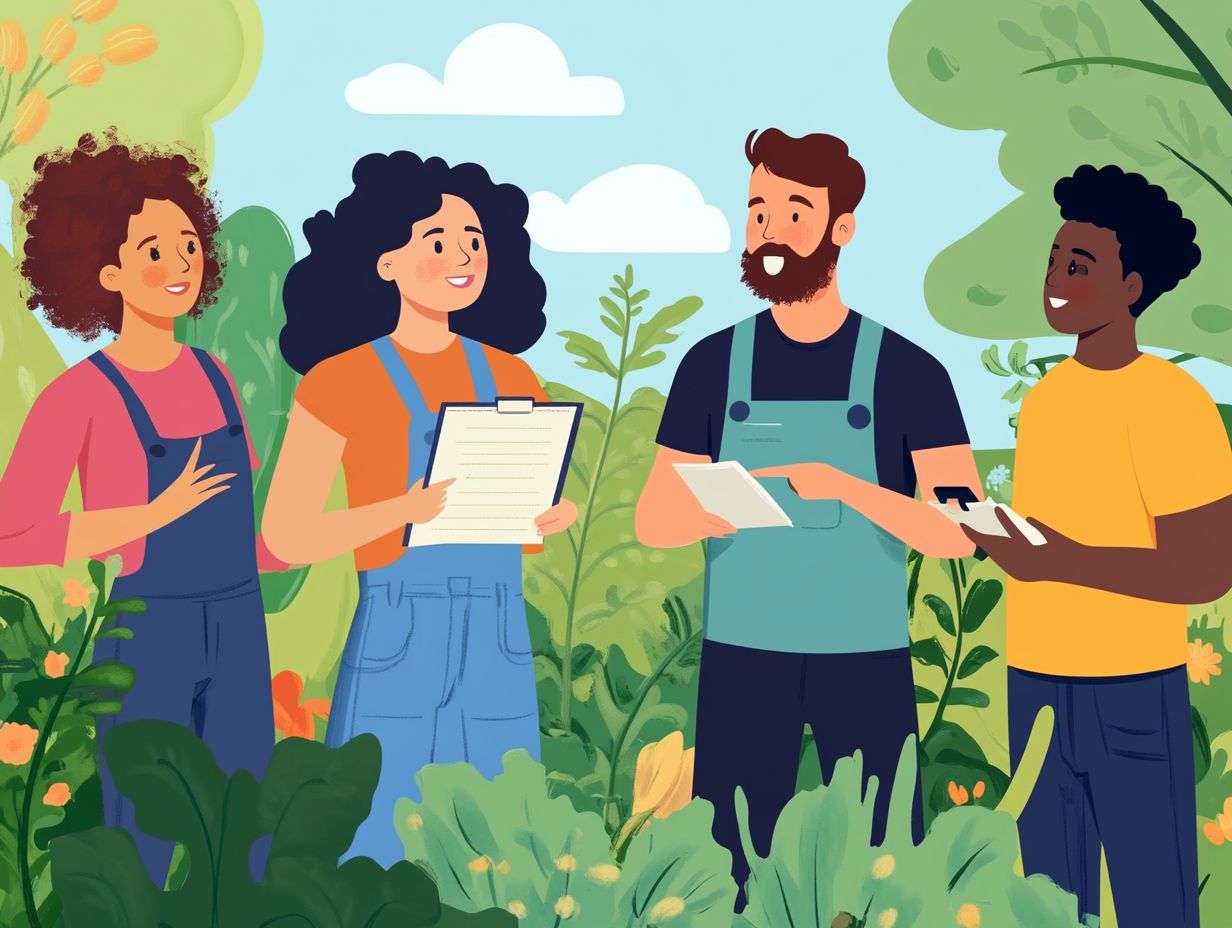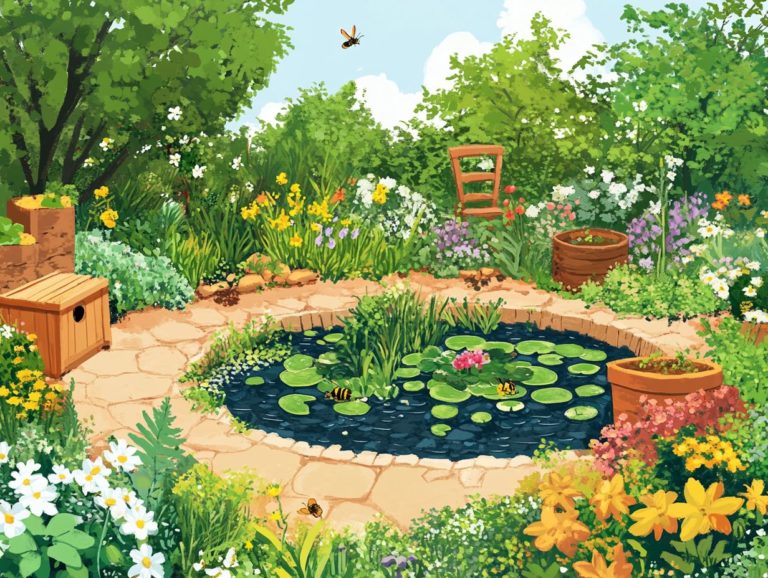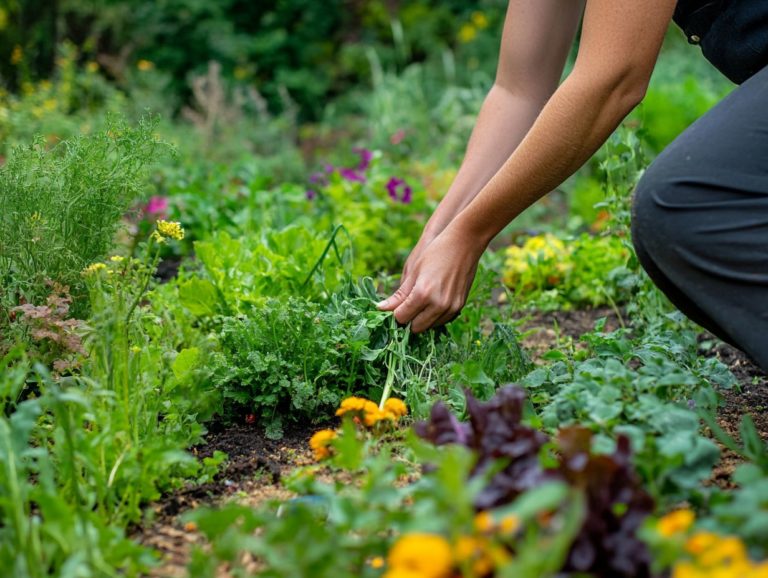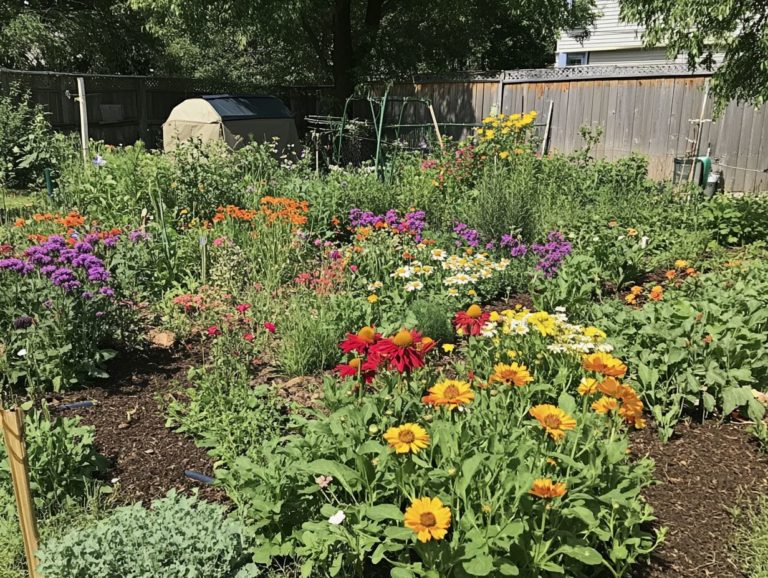How to Share Your Permaculture Success Stories?
Sharing permaculture success stories goes beyond personal achievements. It inspires others and fosters a vibrant community. Each narrative you tell holds the potential to motivate both seasoned practitioners and curious newcomers to embrace sustainable practices.
This article will guide you in identifying your own successes, selecting the most effective platforms for sharing, and crafting compelling narratives that truly resonate. You’ll also discover techniques for engaging storytelling and methods to connect with the broader permaculture community.
Dive in and uncover how your experiences can make a real difference! Together, we can contribute to a greener future.
Contents
- Key Takeaways:
- The Importance of Sharing Permaculture Success Stories
- Identifying Your Success Story
- Choosing the Right Platform for Sharing
- Crafting Your Story for Maximum Impact
- Tips for Engaging and Informative Storytelling
- Sharing Your Story with the Permaculture Community
- Frequently Asked Questions
- What is permaculture and why should I share my success stories?
- How can I share my permaculture success stories?
- What are some tips for effectively sharing my permaculture success stories?
- Can I share my permaculture success stories if I am just a beginner?
- How can I make my permaculture success stories more relatable to others?
- Can I share my permaculture success stories even if they are small or seemingly insignificant?
Key Takeaways:

The Importance of Sharing Permaculture Success Stories
Sharing permaculture success stories is essential for inspiring both individuals and communities to adopt sustainable practices. These narratives highlight real-life examples of how permaculture principles can transform land into self-sustaining farms and thriving businesses.
Pioneers in the field, like Elizabeth Waddington and Mike Dorion, have set a remarkable precedent by showcasing effective soil management techniques and cultivating diverse crops. Their efforts not only boost food production but also enrich local ecosystems through initiatives like community gardens and educational programs.
Inspiring Others and Building Community
Inspiring others through your personal stories of permaculture success fosters community engagement and cultivates a shared commitment to sustainability. By sharing vivid narratives that spotlight transformative experiences in environmental practices, you can spark curiosity and motivate action among your peers.
Organizing workshops is another powerful approach, allowing participants to acquire hands-on skills and connect with like-minded individuals. This reinforces their dedication to green initiatives. Using social media platforms can amplify your message and create opportunities for collaborations with local businesses eager to promote environmental education.
Through these interactions, you can help form networks of support within your community, igniting a collective passion for sustainable living that resonates far beyond individual efforts.
Identifying Your Success Story
Identifying your permaculture success story starts with acknowledging the distinctive elements of your journey. This includes everything from applying permaculture design principles the design methods that help create sustainable ecosystems to crafting a profitable business model that prioritizes sustainability.
Emphasizing income generation through diverse crops and organic certification is key to your narrative.
Defining Success in Permaculture
Success in permaculture is all about your ability to create a self-sustaining farm that addresses financial concerns and makes a positive impact on the local environment and community.
This multifaceted approach encourages you to integrate diverse income streams think organic produce sales, farm-related tourism that allows visitors to experience farm life, and artisan goods ensuring your economic viability while keeping your ecological footprint in check.
You’ll want to evaluate your environmental impact through practices like improving soil health, promoting biodiversity, and conserving water. These will serve as benchmarks for sustainable growth.
A thriving permaculture initiative also relies on community involvement. Engage local residents in workshops, volunteer opportunities, and educational programs to cultivate a shared sense of stewardship and connection to the land.
By embracing these principles, you can enhance the overall resilience and harmony of your ecosystem, demonstrating that an interconnected approach is the key to long-term success.
Choosing the Right Platform for Sharing

Selecting the ideal platform to share your permaculture success story is essential for building a community around sustainable practices.
Whether you choose social media, blogs, or educational programs tailored to engage various demographics, your choice will significantly impact your ability to inspire others.
Social Media, Blogs, and Other Options
Social media and blogs are fantastic ways to share permaculture stories. They allow you to connect with a broader audience and encourage community involvement through shared experiences.
By using visual storytelling on platforms like Instagram or engaging with local groups on Facebook, you can showcase the vibrant life of community gardens and the impactful educational programs surrounding them.
Personal blogs are invaluable for diving deeper into workshop services. Here, you can share your successes, offer tips, and discuss challenges. This unique blend of storytelling not only highlights the importance of sustainable practices but also inspires others to get involved, reinforcing a sense of community among gardening enthusiasts and local businesses.
Crafting Your Story for Maximum Impact
To craft your permaculture story effectively, weave in key elements that resonate with your audience. It s important to highlight how you embody permaculture principles that foster sustainability and community development.
Key Elements to Include
- Initial motivations
- Techniques applied
- Challenges faced
- Role of community involvement
These aspects form a narrative that resonates with those starting their own sustainable journeys. Reflecting on what sparked your interest in permaculture offers valuable context. Perhaps it was a desire to reconnect with nature, reduce waste, or cultivate food sustainably.
Detailing specific methods, like companion planting or rainwater harvesting, illustrates practical applications. Sharing your personal triumphs and setbacks adds authenticity and engages local groups, fostering knowledge sharing and a supportive network during the permaculture process.
Tips for Engaging and Informative Storytelling
When crafting engaging storytelling for the permaculture community, it s essential to use language that resonates. Incorporate visuals that captivate the eye and enhance understanding.
Provide actionable insights that inspire others to explore sustainable practices and embrace permaculture techniques on their own journeys. This approach enriches the narrative and encourages individuals to implement these valuable practices.
Techniques for Captivating Your Audience

Captivating your audience involves storytelling methods that harness the power of emotion, humor, and relatable experiences. These elements resonate deeply with the core values of permaculture and sustainability.
By employing a well-structured narrative, you can weave in personal anecdotes and transformative experiences that connect with learners profoundly. This approach fosters an emotional bond, making complex concepts more digestible and inspiring.
Actively engaging community feedback can enrich your storytelling further. It allows for diverse perspectives that enhance understanding and inclusivity. In your educational programs, integrating these techniques elevates the learning experience and cultivates a sense of shared purpose among participants.
Start sharing your own stories today and inspire others!
Sharing Your Story with the Permaculture Community
Sharing your story with the permaculture community is crucial for cultivating networks and collaborations that advocate for organic certification and sustainable farming practices. Your participation enriches collective knowledge and fosters an environment where innovation and sustainability can thrive.
Networking and Collaborating with Others
Networking and collaborating within the permaculture community can elevate your experience through enriched knowledge sharing and resource pooling. This collaboration fosters the creation of innovative workshop services that embrace sustainable practices, such as compost tea production, a nutrient-rich liquid made from steeping compost in water, used to nourish plants.
Through these connections, you can tap into the wisdom of seasoned practitioners, gaining insights that might otherwise remain just out of reach. Co-hosting events broadens the audience for fundamental permaculture teachings and nurtures a dynamic environment for the exchange of ideas and techniques.
Share your resources and watch your community projects thrive! Whether it’s seeds, tools, or even volunteer time, you can initiate impactful community projects, like establishing food forests or implementing rainwater harvesting systems. Learning from one another s experiences fosters a sense of camaraderie, ultimately fortifying the permaculture movement while promoting sustainable practices that benefit both the environment and local ecosystems.
Frequently Asked Questions
Permaculture is a sustainable design system aimed at creating fair and environmentally-friendly food production while supporting biodiversity. Sharing your success stories can inspire others to adopt permaculture practices and contribute to a more sustainable future for our planet.

There are many ways to share your permaculture success stories:
- Writing articles or blog posts
- Creating videos or podcasts
- Participating in community events or workshops
- Sharing on social media platforms
What are some tips for effectively sharing my permaculture success stories?
Some tips for effectively sharing your permaculture success stories include:
- Being authentic and honest
- Using visuals to enhance your story
- Including specific details and results
- Using a positive and empowering tone to inspire others
Yes! Everyone has their own unique journey with permaculture, and sharing your experiences even as a beginner can still inspire and educate others. Don’t hesitate to share both your successes and challenges, as they can provide valuable lessons for others.
How can I make my permaculture success stories more relatable to others?
To make your permaculture success stories more relatable, include details about common challenges or obstacles you faced and how you overcame them. This can help others see that they can also achieve success with permaculture, despite any challenges they may face.
Absolutely! Every step towards a more sustainable and regenerative lifestyle is important and worth sharing. Don’t underestimate the impact of your small successes; they can inspire others to take action and make a positive difference in their own lives.
Start sharing your permaculture journey today and make a difference!






